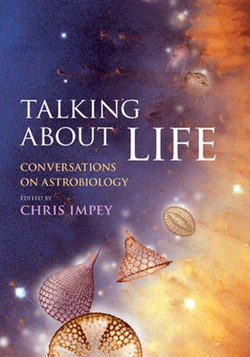Review: Talking About Lifeby Jeff Foust
|
| “I call it the science of optimism, because we’re going after something we know may not exist, and even if it does exist it may take more than our lifetime just to find it,” says one astrobiologist. |
The actual announcement was underwhelming for those who bought into the hype. Scientists did announce the discovery of bacteria that incorporated arsenic into its structure, replacing phosphorus, but those bacteria came not from Titan but instead from California’s Mono Lake. The astrobiological significance of the discovery—broadening, in effect, the definition of life by including an element not previously considered an essential building block—was lost in the backlash about NASA overselling the finding and, subsequently, debate about the validity of the discovery and the appropriate fora (blog posts and commments versus peer-reviewed scientific papers) for that debate.
While astrobiology might have gotten short shrift in this latest discovery, this interdisciplinary field continues to make progress, both in scientific discoveries and acceptance as a legitimate field of study. In Talking About Life, Chris Impey, a University of Arizona astronomer and author (see “Review: How It Ends”, The Space Review, August 23, 2010) examines this field by talking to a diverse range of people involved in studying the prospects for life beyond Earth.
As the book’s subtitle suggests, Talking About Life consists of a series of interviews conducted by Impey with over three dozen people who have played a role, in one manner or another, in studying the potential for life to exist elsewhere in the universe. Many of the people Impey interviews are well-known scientists in various areas: extrasolar planet discoverers Geoff Marcy and Debra Fischer, planetary scientists Carolyn Porco and Peter Smith, and SETI researchers Jill Tarter and Seth Shostak, among others. There’s also a variety of other people who have contributed to astrobiology in one way or another, or who otherwise can provide insights on the search for life, from former NASA historian Steven Dick to journalist Timothy Ferris to Carl Sagan’s widow, Ann Druyan. (Also included in the book is one of the participants in last month’s NASA press conference, Steven Benner, talking about the potential for biochemistries beyond what we normally associate with supporting life; the interview, of course, predates the press conference.)
Each chapter consists of a brief introduction of a particular person, followed by a transcript of Impey’s interview with them (edited to “improve clarity and flow”, Impey notes in the book’s introduction). This approach has its strengths and weaknesses. Allowing each person to speak in their own words, and preserving the give and take between Impey and the interviewee, helps humanize them, turning them from experts in a particular discipline to people who were driven by a variety of influences to pursue research or other work related to astrobiology. The weakness, though, means that the reader has to sometimes plow through passages in each interview that have nothing to do with the subject: it may be fascinating, for example, to find out how Ferris got his break writing for Rolling Stone, but you’re left wondering what it has to do with the search for life on other worlds. One interview, with former astronaut Pinky Nelson, focuses almost exclusively on his experience as an astronaut and thoughts about human spaceflight, touching only at the end on life elsewhere.
Nonetheless, Talking About Life is an impressive book, allowing scientists and others to speak in the own words, and in detail, about the efforts to understand the prospects for life in the universe. It also makes clear that the field is one that combines not just various scientific disciplines but, to some degree, philosophical ones as well. “I call it the science of optimism, because we’re going after something we know may not exist, and even if it does exist it may take more than our lifetime just to find it,” said John Baross, an astrobiologist who got his start in oceanography, in one of the book’s interviews. It’s a reminder that, despite the hype of breakthrough announcements, there’s a lot of work ahead for researchers trying to understand the potential for life in the universe.
